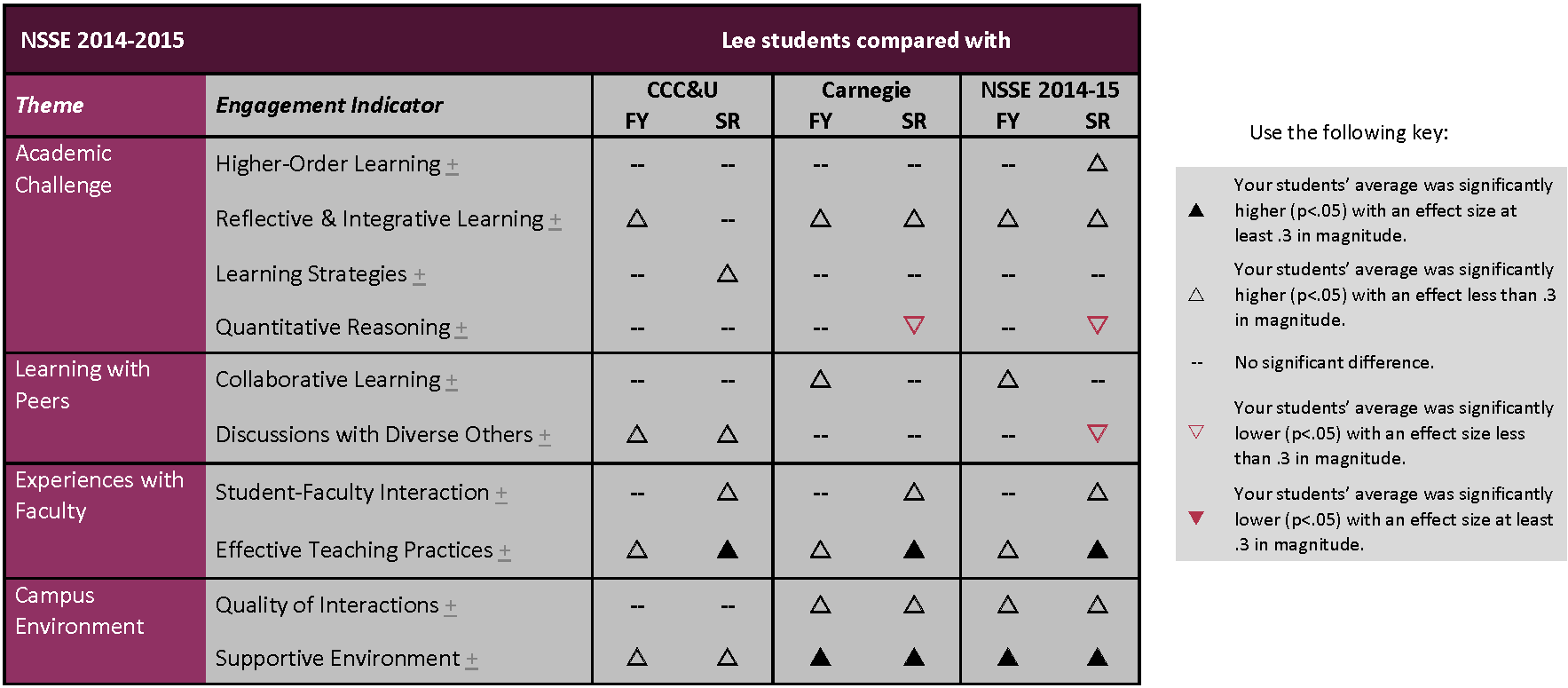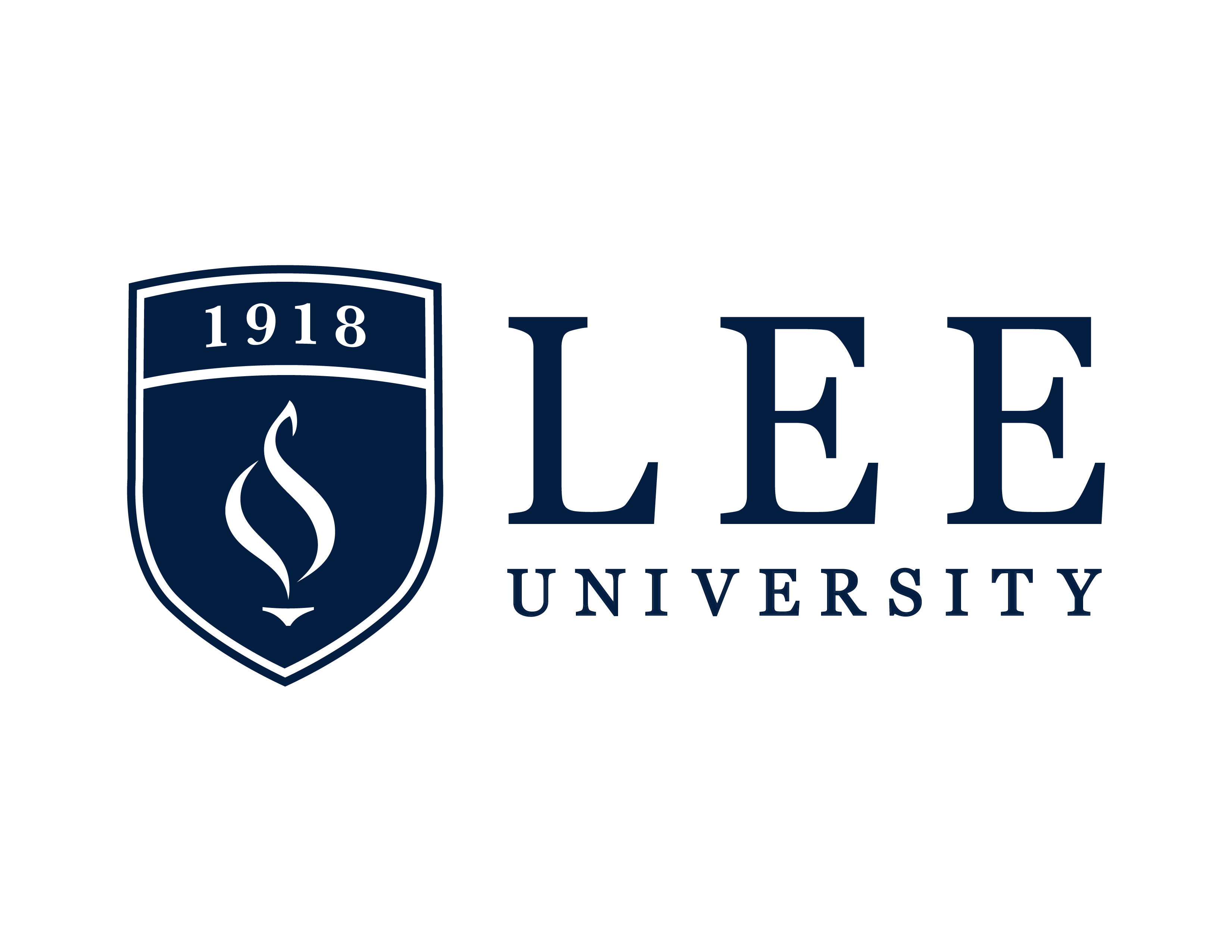Lee University evaluates success with respect to student achievement according to our stated mission to help students develop knowledge, appreciation, understanding, ability, and skills which will prepare them for responsible Christian living in a complex world.
The criteria we use to evaluate student success include graduation, retention, job placement rates, general education testing, major field tests, and nationally normed self-report studies. Data analysis is part of our Institutional Effectiveness process, as well, and includes review by appropriate faculty and administrative staff. Through these practices, we ensure student success that is appropriate for an institution of higher learning.
Graduation and retention rates are the most common measures of student success among higher education institutions. Lee University’s benchmarks are based on national comparisons of similar institutions with high acceptance rates and a select group of peer institutions who are slightly more selective yet have cultural similarities within our state.
The wider mission of Lee, discussed in the Extended Statement of Institutional Purpose, involves serving a wide variety of students from different backgrounds and with varying levels of academic ability. This includes under prepared students as well as high-achieving students. Because of this, our benchmarks are based on the national averages for each criterion, where available. In 2014, Lee University established a goal to increase the 6-year graduation rate of entering freshmen cohorts to 55% by fall 2020. The minimum threshold for graduation rates was set at 50%.
Our most recent rates exceed our five-year averages (except in a few categories with small cohort sizes which are subject to large swings in the percentages) and are comparable with national rates for four-year institutions with high acceptance rates.
Disaggregated graduation rates are computed by gender, ethnicity, and low-income status on an annual basis. The data show the last five cohorts’ graduation rates for each of the categories mentioned above, as well as Lee’s 5-year average and national comparisons from the most current data from the National Center of Education Statistics (NCES). In virtually all comparisons, Lee University five-year averages meet or exceed national standards, which as stated above, forms our benchmark comparison goals for graduation rates. View all Graduation Rate data through the link below:
Similar to our graduation rates, the supporting goal of increasing retention rates of full-time, first-year students is also an indicator of student success. The wider mission of Lee, discussed in the Extended Statement of Institutional Purpose, involves serving a wide variety of students, from different backgrounds and with varying levels of academic ability. This includes underprepared students as well as high-achieving students. Because of this, our benchmarks are based on the national averages for each criterion, where available. Based upon our historic 5-year rate in 2014 we established a minimum retention threshold of 73% with a goal of reaching 78% by fall 2020. Our most recent retention rate is well above the comparable rate for 4-year institutions with high acceptance rates.
Lee Freshman retention rate Fall 2022 to Fall 2023: 81%
Lee Average Freshman retention rate (past 5 years): 80%
NCES 4-year nonprofit with acceptance rates of 90% or more, 2020 to 2021 retention rate: 70.7%
View Peer Institution data from the National Center of Education Statistics
Lee Online
Lee Online (distance learning) is designed to serve a much more transient student population who often enter our distance learning programs with college credit from numerous prior learning experiences. Our minimum threshold for retaining Lee Online students from one semester to the next (removing students who graduate) is set at 65% and is based on historical retention rates from this population. Our goal is to increase this number to 75% by improving student success and support services.
The most recent retention rates show improvement in retention, and the recent addition of student success coaches for Lee Online students has contributed to reaching our 2025 goal of 75% retention a few years early.
Lee Online Retention Rates
Fall 2017 to Spring 2018: 67%
Fall 2018 to Spring 2019: 68%
Fall 2019 to Spring 2020: 71%
Fall 2020 to Spring 2021: 71%
Fall 2021 to Spring 2022: 73%
Fall 2022 to Spring 2023: 77%
The Center for Calling and Career at Lee University conducts a survey of graduating seniors^ the month prior to graduation regarding employment status after graduation. Lee established a goal in 2014 to increase the job placement rate of graduating seniors from 53%, our minimum threshold, to our goal of 65% by fall 2020.
The average rate for having received or accepted job offers prior to graduation or for continuing education incrementally increased from 53% in 2013 to 61% in 2023. Another 24% were seeking employment but had not secured a job. Twelve percent were employed part-time, and 3% indicated they were not seeking employment. Of those who received or accepted job offers, 85% said the job was “definitely” or “somewhat” related their degree at Lee University. Seventy-two percent indicated this is their dream job. Eighty-nine percent indicated their job was “definitely” or “somewhat” related to their career goals.
According to the most recent Alumni Survey*, within 6 months after graduation, 82% of one-year alumni (who responded) were employed full-time or enrolled in continuing education full-time. 74% had a full-time job.
^The Center for Calling and Career survey was administered in Spring 2023. It is required for all students to respond to the survey. Data presented here include only traditional undergraduate completers.
*The Alumni Survey was administered in Spring 2023 to students who completed their bachelor’s degree in Fall 2021, Spring 2022, and Summer 2022 (one-year alumni cohort) and Fall 2017, Spring 2018, and Summer 2018 (five-year alumni cohort). The response rate for the one-year alumni was 17%.
As an institution that values liberal arts education, Lee University is interested in general education competencies of graduating seniors. Annually, the institution uses a variety of assessment tools to measure these competencies. One commonly used measure of general education knowledge and skills is the ETS Proficiency Profile (formerly the Academic Profile). Lee has consistently scored above the national mean in total score and in subscale scores of different skill areas on the Proficiency Profile. Because of Lee’s diverse student population, the benchmark for standardized tests such as this is the national norm. Our goal is that our subscale scores and total score meet or exceed the national mean for both. The charts below display the most recent set of Lee scores with the national mean comparison and 5-year longitudinal data.
General Education Test Longitudinal Data
Division of Adult Learning
For the Division of Adult Learning, the most recent administrations of the Proficiency Profile yielded positive results. DAL students, on average, scored above the national mean for non- proctored administrations in total score and most sub-scores. While many adult learners bring their general education to Lee from other institutions, we still measure student performance for these students on nationalized examinations, and like our traditional undergraduates, our goal is that the adult learners meet or exceed national norms.
Division of Adult Learning Proficiency Profile Longitudinal Report
Most academic programs, where national major field tests are available, administer these tests as part of their annual outcomes assessment. Lee University participates in the following major field tests offered by ETS: Business, English (Literature), Mathematics, Music, Political Science, and Sociology and the following field exams offered by ACAT: Biology, Health Science, History, Human Development, and Psychology. The institution compares favorably with the national norms (Lee’s benchmark) for most areas. Just like our general education assessments, our goal is that average scores for each major field test meet or exceed national mean scores. One stand-out example of student success comes from the 2013-2014 administrations of the ACAT Major Field Test, where, on average, senior Biology students scored in the 92nd percentile range compared with their respective reference group.
Lee University tracks passage rates for programs with licensing examinations. These exams are a common metric of student achievement for accreditation organizations and our programs. Lee often uses these pass rates as a means of assessing student learning outcomes in the assessment process and are compared with statewide pass rates for each content area. Minimum thresholds are established by the accrediting bodies for professional licensures since programs should meet the minimum standards of accreditation. Goals are created for each licensure based upon the program requirements and accreditation standards.
Marriage and Family Therapy (MFT), Behavioral and Social Sciences
Teacher Licensure, College of Education
Athletic Training Program, Health Exercise Sciences & Secondary Education, College of Education
School Counseling Graduate Program, Behavioral and Social Sciences
School of Nursing
NCLEX RN Passage Rates
The Commission on Collegiate Nursing Education (CCNE) has established minimum thresholds for licensure first time passage rates of 70% or better and the State of Tennessee requires an 85% average passage rate. Lee University School of Nursing utilizes these rates to establish minimum thresholds while establishing a goal that 90% of students will pass the NCLEX exam the first time.
| NCLEX NR Pass Rate | 2017 | 2018 | 2019 | 2020 | 2021 | 2022 | 2023 |
| Lee Results | 100% | 100% | 96.90% | 96% | 97% | 96.84% | 100% |
| Lee Goal | 90% | 90% | 90% | 90% | 90% | 90% | 90% |
| State of TN Minimum Threshold | 85% | 85% | 85% | 85% | 85% | 85% | 85% |
| National Pass rate | 85% | 85% | 87% | 88% | 83% | 80% | 80% |
| TN state Pass rate | 87% | 90% | 92% | 92% | 88% | 86% | 86% |
FNP Certification Passage Rates
FNP Certification first time passage rates are used to measure student achievement for graduates of Lee’s DNP programs. The first graduating cohort for this program was 2021.
| FNP Certification Pass Rate | 2021 | 2022 | 2023 | ||||
| Lee Results | 100% | 100% | 100% | ||||
| CCNE Threshold | 80% | 80% | 80% | ||||
| FNP National Pass Rate |
Student engagement represents two critical features of collegiate quality. The first is the amount of time and effort students put into their studies and other educationally purposeful activities. The second is how the institution deploys its resources and organizes the curriculum and other learning opportunities to get students to participate in activities that decades of research studies show are linked to student learning.
Through its student survey, The College Student Report, the National Survey of Student Engagement or NSSE annually collects information at hundreds of four-year colleges and universities about student participation in programs and activities that institutions provide for their learning and personal development. The results provide an estimate of how undergraduates spend their time and what they gain from attending college. To focus discussions about the importance of student engagement and to guide institutional improvement efforts, NSSE created 10 Engagement Indicators within four broad themes: Academic Challenge, Learning with Peers, Experiences with Faculty, and Campus Environment.
The table below compares average scores for Lee students with those in our comparison groups.

